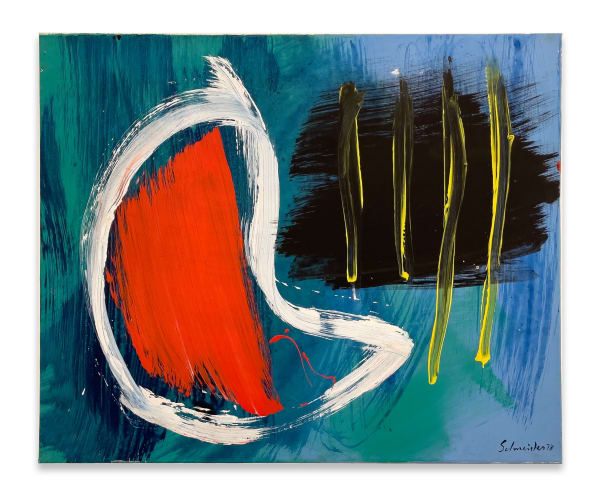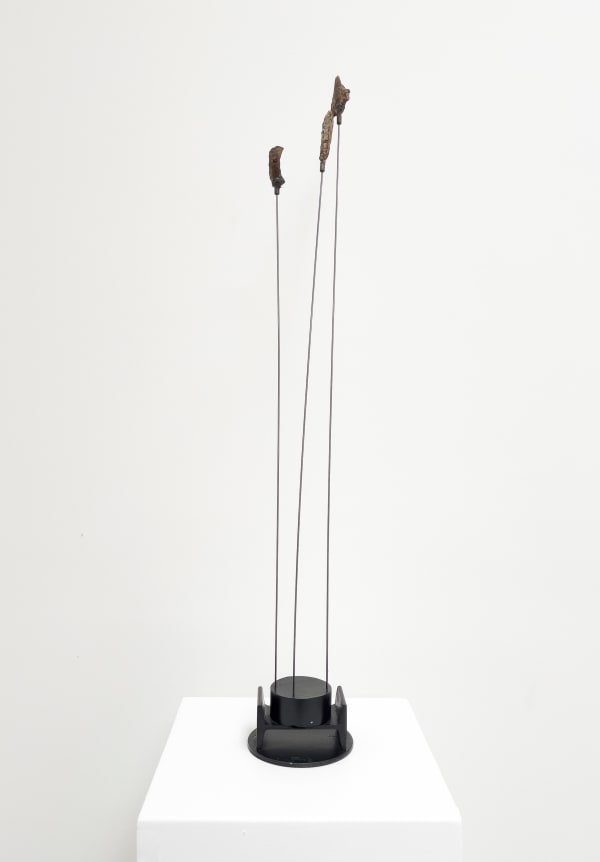Lyrical Gestures: Schneider & Takis
Musicality unites two important 20th century artists: Gérard Schneider, a key figure of Lyrical Abstraction, and kinetic art pioneer Takis. Exhibited together for the first time, their works are rife with movement––whether conveyed through gestural brushstrokes or magnetic force––presenting a pervasiveness of rhythm.
Schneider’s canvases capture a mood in permanence. In the footsteps of Kandinsky, his works are inherently musical. A synthesis of sound and vision, Schneider’s expressive paintings were executed with impulsive bodily movements, creating lines that take unexpected twists and turns. Works following his post-war period as seen here opened a path toward a more liberated style with a calligraphic quality: brushstrokes became less predicated much like his abstract expressionist contemporaries. He titled many of his works ‘Opus’, a nod to the ongoing titling system of musical compositions.
Takis gave life to his works in a different way, uniting art and science through metallic instruments subject to gravity and magnetic fields. Takis’ interest in ancient Greek theater, music, and culture inspired him to create works that could also “perform” like actors or musicians. His Signals series feature metallic weights balanced on piano strings––swaying lines––susceptible to movement only with force. Later sculptures departed from this idea and began to move and create music on their own, like the series Musicales.
Together, Schneider and Takis take art to symphonic heights. Where words cannot describe the intangible aspects of their work, music does. The exhibition moves like an orchestra under the baton of the two artists. The vivace of Schneider’s vibrant paintings, combined with the rubato of Takis’ moving sculptures creates an impressive modernist duet.
Gérard Schneider was born in Switzerland in 1896. At 20 he relocated to Paris where he studied at the École Nationale des Arts Décoratifs, and later at the École Nationale des Beaux-Arts de Paris in the studio of the painter Fernand Cormon, teacher to van Gogh and Toulouse-Lautrec. During his time in Paris, Schneider frequented musical circles which informed his early works, featuring a movement-based expression. He was exposed to the likes of Picasso and Kandinsky who had famously departed from reality in their work. It was just at the cusp of the war that Schneider would enter a new phase of his career, venturing into what is now called Lyrical Abstraction. Along with artists such as Hans Hartung and Pierre Soulages, the lyrical abstractionists took art to another dimension, their art being unwary, animated modes of communication. This takes center stage in Schneider’s works and would characterize his oeuvre as we know it today. The later 1940s saw an abundance of expositions between Europe and the United States where he landed exclusive representation at Sam Koontz Gallery in New York. This was followed by a series of institutional acquisitions at the MoMA and the Phillips Collection. A landmark retrospective exhibition was famously held in Brussels in 1953 at the Musée d’Art Moderne showcasing the progression of his style which became more liberated in the post-war period. In the 1960s, Schneider's work gained a wilder expressionist quality, utilizing brighter colors. The French pavilion at the 1966 edition of the Venice Biennale featured a solo exhibition of these “free” works. Today Schneider’s work can be found in the world’s most prestigious collections, including the Musée d’Art Moderne, Brussels, the MoMA, New York, Galleria d’Arte Moderna, Rome, the Centre Pompidou, Paris, Museu de Arte Moderna do Rio de Janeiro, Rio de Janeiro and the Montréal Museum of Fine Arts, Québec, among many others; and has been featured at Documenta twice. Schneider died in 1986 in Paris.
Better known under his pseudonym Takis, Panagiotis Vassilakis was born in Athens, Greece in 1925. His early interest in physics sparked an artistic career lasting over seven decades centered on magnetism and kinetics, taking art into the domain of science. The incorporation of magnets and electric currents took his work to new heights, making him a leading figure of the kinetic art movement in the 1960s. In his twenties, the self-taught Takis discovered the works of Giacometti and Picasso, subsequently sparking his interest in art while concurrently dabbling in scientific experiments in his parent’s basement. In 1953, he worked in Brancusi’s atelier for several months in Paris and had begun living between the capital city and London. It was during this time that he created his first kinetic works, Signals, largely inspired by the movement of radar antennas. The clashing of objects in these sculptures, as in his other works like Musicales, create sounds that produce irregular melodies and harmonies. For Takis, art and science were not dissimilar as both artists and scientists sought answers to universal questions. In 1968 he was invited to the Massachusetts Institute of Technology as a researcher. It was through experiences across Europe and the United States that he met with beat poets like Gregory Corso and Allen Ginsburg, whose works made a great impression on Takis. In 1969, he co-founded the Art Workers Coalition in New York which advocated for diversity in museums and artists rights. Takis’ work has been extensively exhibited in prestigious venues around the world, most recently at the Tate Modern in 2019. This also includes twice at Documenta in 1977 and 2017, the Venice Biennale in 1995, and the Paris Biennale in 1985, winning the first prize. In the last decade, his work was exhibited at MACBA Museu d'Art Contemporani de Barcelona, the Tate Modern, London, Palais de Tokyo, Paris, and the Menil Collection, Houston. His work is collected by Centre Pompidou, Paris, the MoMA, New York, the Guggenheim Museum, New York, and the Tate, London, among many others.
We would like to thank Laurence Schneider and Christian Demare, Archives Gérard Schneider, and Takis Foundation for their support. All images are copyright of their respective foundations and ADAGP, Paris, 2022.
-
 Gérard SchneiderComposition, 1975oil on canvas114 x 146 cm
Gérard SchneiderComposition, 1975oil on canvas114 x 146 cm
44 7/8 x 57 1/2 in
framed: 120 x 151 x 4 cm -
 Gérard SchneiderOpus 3H, 1965oil on canvas50 x 61 cm
Gérard SchneiderOpus 3H, 1965oil on canvas50 x 61 cm
19 3/4 x 24 in
Framing dimensions: 83.5 x 99.5 x 5.5 cm -
 Gérard SchneiderOpus 55M, 1978acrylic on canvas50 x 61 cm
Gérard SchneiderOpus 55M, 1978acrylic on canvas50 x 61 cm
19 3/4 x 24 in -
 Gérard SchneiderOpus 56N, 1981oil on canvas86 x 116 cm
Gérard SchneiderOpus 56N, 1981oil on canvas86 x 116 cm
33 7/8 x 45 5/8 in
Framed : 97 x 124 x 5,5 cm -
 Gérard SchneiderOpus 62M, 1978oil on canvas35 x 27.5 cm
Gérard SchneiderOpus 62M, 1978oil on canvas35 x 27.5 cm
13 3/4 x 10 7/8 in -
 Gérard SchneiderOpus 69C, 1956oil on canvas100 x 81 cm
Gérard SchneiderOpus 69C, 1956oil on canvas100 x 81 cm
39 3/8 x 31 7/8 in
framed: 103 x 83 x 4 cm -
 Gérard SchneiderUntitled, 1970acrylic on canvas37 x 41 cm
Gérard SchneiderUntitled, 1970acrylic on canvas37 x 41 cm
14 5/8 x 16 1/8 in
Framed : 56 x 62 x 3,5 cm -
 Gérard SchneiderUntitled, 1970oil on canvas33 x 41 cm
Gérard SchneiderUntitled, 1970oil on canvas33 x 41 cm
13 x 16 1/8 in
Framed : 48 x 56 x 4,5cm -
 Gérard SchneiderUntitled, 1985Acrylic on paper laid on canvas150 x 100 cm
Gérard SchneiderUntitled, 1985Acrylic on paper laid on canvas150 x 100 cm
59 x 39 3/8 in
Framed: 156 x 113 x 3.5 cm -
 Takis, Signal, 1979
Takis, Signal, 1979 -
 Takis, Signal, 1972
Takis, Signal, 1972 -
 Takis, Télésculpture, 1960 c.
Takis, Télésculpture, 1960 c. -
 Takis, Isidos Plant, 1980
Takis, Isidos Plant, 1980 -
 Takis, Plante d'Isis, 1997
Takis, Plante d'Isis, 1997 -
 TakisSignal, 1985iron and found objects98.7 x 109.3 cm
TakisSignal, 1985iron and found objects98.7 x 109.3 cm
38 7/8 x 43 in -
 Takis, Signal, 1978
Takis, Signal, 1978 -
 Takis, Signal, 1979
Takis, Signal, 1979 -
 Takis, Signal , 1974
Takis, Signal , 1974




















